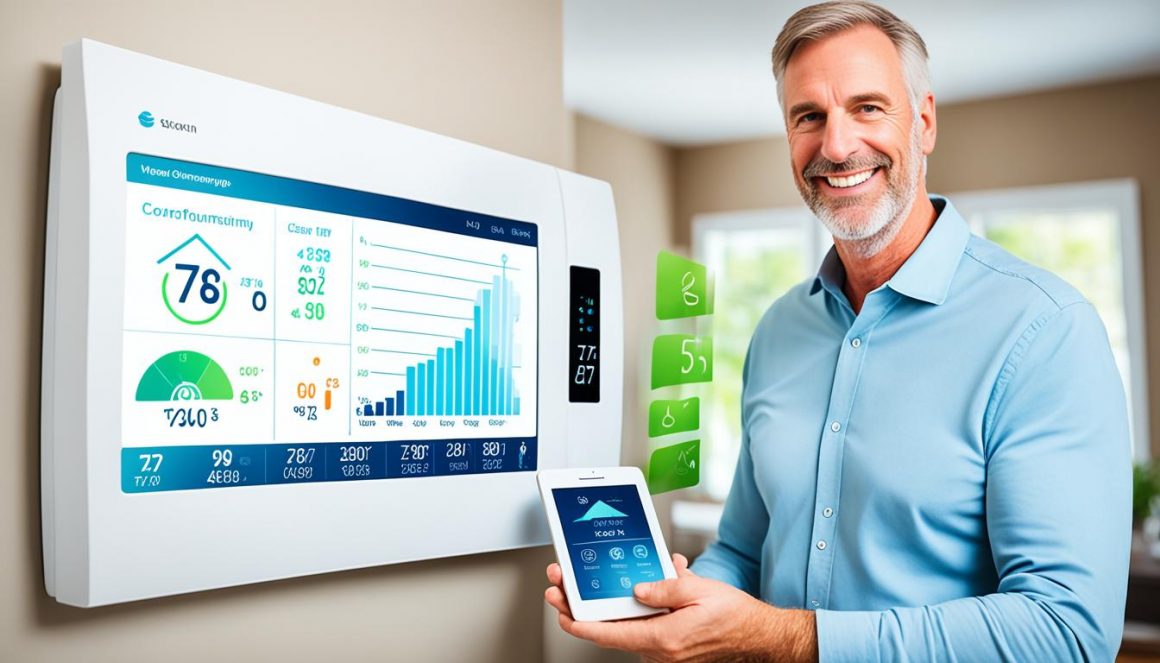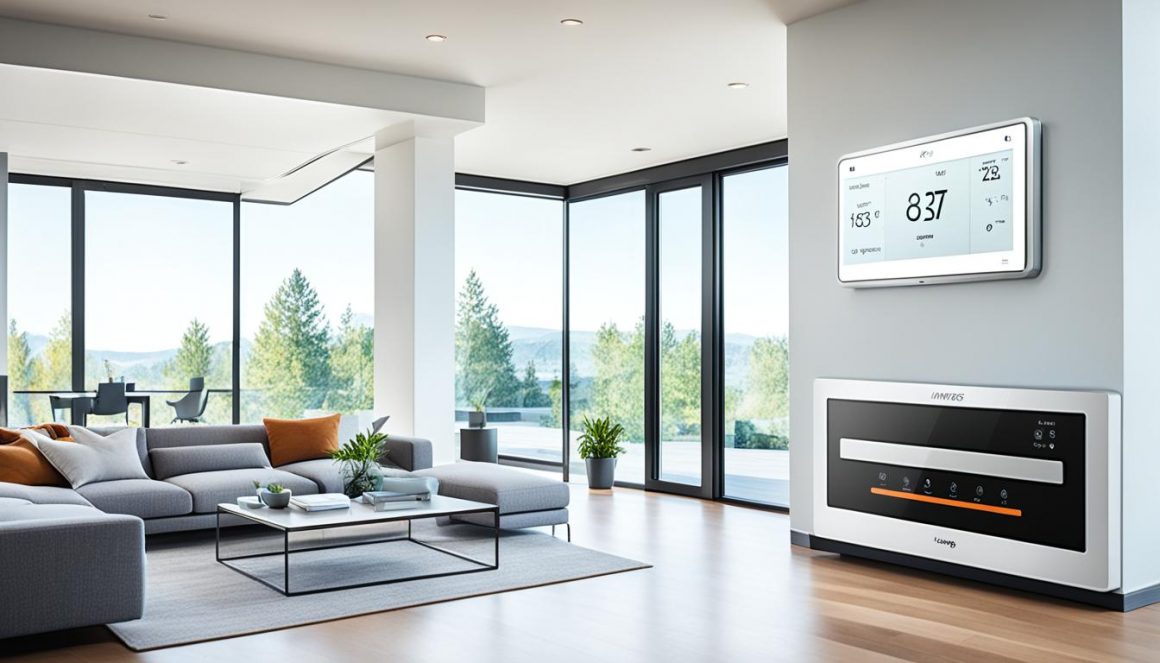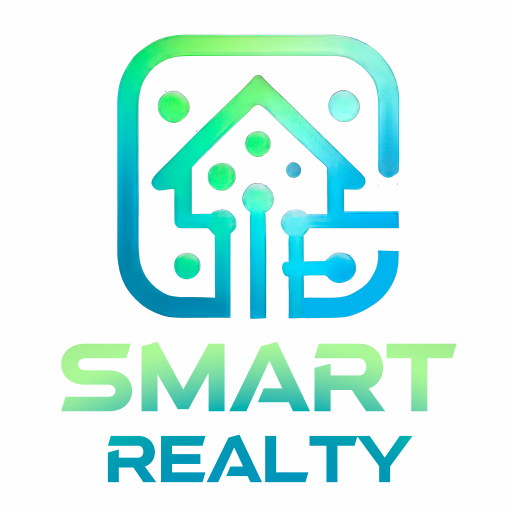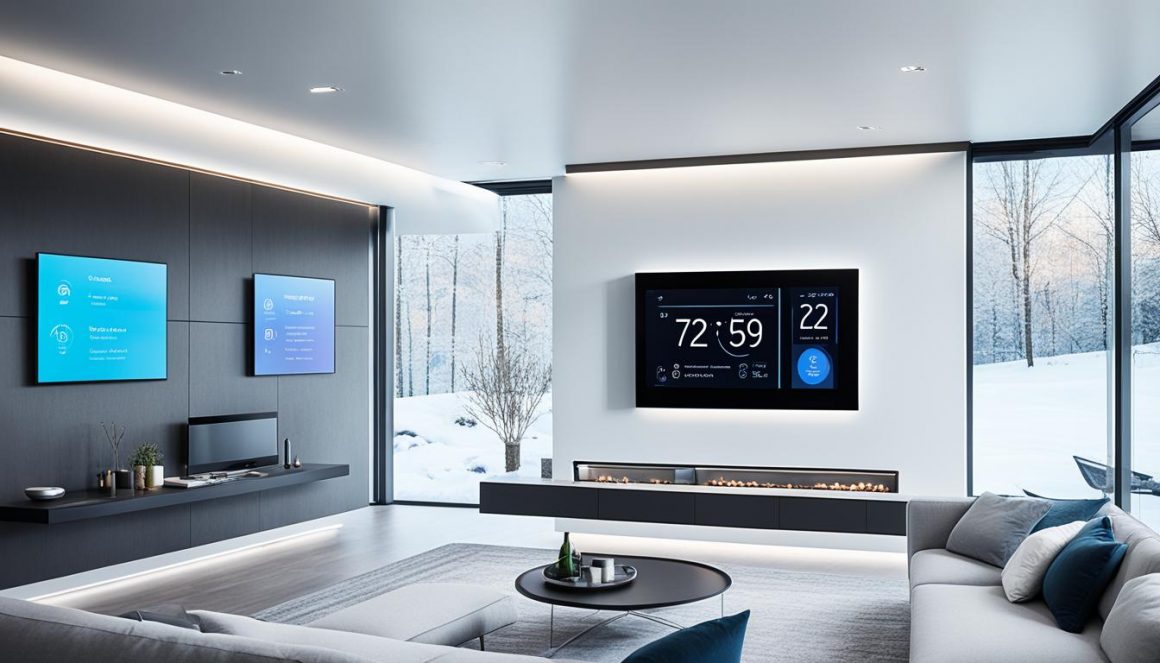Integrating HVAC systems into a smart home climate control network is revolutionizing the way homeowners manage their home’s temperature. By seamlessly integrating HVAC systems with smart home technology, you can enhance comfort, convenience, and efficiency. Automated HVAC control through a smart climate control network allows for personalized temperature settings, remote access, and optimized energy savings.
One of the key components of smart HVAC integration is the use of smart thermostats, such as those offered by Nest and Ecobee. These thermostats enable easy remote access and control of your heating and cooling system, allowing you to adjust the temperature from anywhere using your smartphone. With the integration of smart devices, HVAC systems can be managed effortlessly, providing a comfortable living environment.
The benefits of smart home technology for HVAC systems are significant. By integrating your HVAC system into a smart home ecosystem, you can enjoy enhanced comfort, improved energy efficiency, and remote access to control your home’s temperature. Additionally, smart HVAC integration offers zoned heating and cooling, personalized settings, and optimized energy savings through sensors, AI, and automation.
In conclusion, smart HVAC integration is transformative, offering homeowners the ability to control and manage their home’s climate with ease. With the integration of smart thermostats and other smart devices, you can enjoy enhanced comfort, convenience, and energy efficiency. Embrace the power of smart HVAC technology and create a connected and intelligent home environment.
Key Takeaways:
- Integrating HVAC systems into a smart home climate control network enhances comfort, convenience, and efficiency.
- Smart thermostats play a central role in HVAC integration, allowing for remote access and control.
- Smart HVAC integration enables zoned heating and cooling, personalized comfort settings, and optimized energy savings.
- Energy savings, enhanced safety, and security are additional benefits of smart HVAC integration.
- Getting started with smart HVAC integration involves choosing compatible devices and professional installation.
The Benefits of Smart Home Technology for HVAC Systems
Smart home technology offers a range of benefits when integrated with HVAC systems. By connecting your HVAC system to a smart home ecosystem, you can enjoy enhanced comfort, energy efficiency, and remote access to control your home’s temperature easily. This seamless integration creates a convenient experience, allowing you to manage your HVAC system along with other connected devices in your home.
Enhanced Comfort
With smart home technology, you have the power to adjust your home’s temperature from anywhere. Whether you’re lying on the couch, at the office, or even on vacation, you can effortlessly control the climate in your home using your smartphone or voice commands. This ensures that you always return to a comfortable environment.
Energy Efficiency
Integrating your HVAC system with a smart home ecosystem enables optimized heating and cooling based on occupancy and environmental factors. Smart thermostats can learn your preferences and automatically adjust temperatures to save energy without compromising comfort. By minimizing energy wastage, you can lower your utility bills and reduce your environmental footprint.
Remote Access
Having remote access to your HVAC system through smart home technology provides convenience and peace of mind. Whether you need to turn on the air conditioning before you arrive home on a hot day or adjust the thermostat during the night without leaving your bed, the ability to control your HVAC system remotely makes life easier and more comfortable.
Smart Home Ecosystem
A smart home ecosystem offers integration and coordination between different smart devices in your home. By connecting your HVAC system to this ecosystem, you can create a cohesive network that allows seamless communication and coordination between your heating and cooling system, lighting, security, and other devices. This integration streamlines your home management and enhances overall efficiency.
| Benefits | Explanation |
|---|---|
| Enhanced Comfort | Easily control your home’s temperature from anywhere, ensuring a comfortable environment whenever you’re at home. |
| Energy Efficiency | Smart HVAC integration optimizes heating and cooling based on occupancy and environmental factors, saving energy and reducing utility bills. |
| Remote Access | Control your HVAC system remotely using your smartphone or voice commands, providing convenience and flexibility. |
| Smart Home Ecosystem | Integrate your HVAC system with other smart devices to create a cohesive network that enhances overall home management and efficiency. |
Smart Thermostats and their Role in HVAC Integration
Smart thermostats are revolutionizing HVAC integration in smart homes, offering advanced features and seamless compatibility with popular home automation platforms. Brands like Nest and Ecobee are leading the way with their state-of-the-art smart thermostats.
Smart thermostats go beyond basic temperature control. They utilize learning algorithms to understand your temperature preferences and schedule. With this information, they automatically adjust heating and cooling based on occupancy, providing optimal comfort while minimizing energy waste.
“Smart thermostats optimize heating and cooling, ensuring you come back to a perfectly comfortable home while reducing your energy consumption.”
One of the standout features of smart thermostats is their ability to provide remote access via smartphones. This means that whether you’re at work, on vacation, or simply in another room, you can easily control your HVAC system with the touch of a button. It brings a new level of convenience and flexibility to managing your home’s climate.
Additionally, smart thermostats offer energy usage reports, allowing you to monitor and track your energy consumption. This valuable information empowers you to make informed decisions about your energy usage and identify areas where you can further optimize efficiency.
Smart thermostats seamlessly integrate with popular home automation platforms like Google Home, Amazon Alexa, and Apple HomeKit. This compatibility enables easy control through voice commands or dedicated mobile apps. You can adjust the temperature, set schedules, and access other smart features, all from the convenience of your preferred smart device.
The Benefits of Smart Thermostats and HVAC Integration:
- Optimized heating and cooling based on occupancy and temperature preferences
- Convenient remote access and control via smartphones
- Energy usage reports for improved efficiency
- Seamless integration with popular home automation platforms
Integrating smart thermostats into your HVAC system brings numerous benefits, including enhanced comfort, energy efficiency, and convenience. With their advanced features and compatibility with smart home platforms, smart thermostats are a crucial component in creating a connected and intelligent home environment.
Zoned Heating and Cooling with Smart HVAC Integration
Smart HVAC integration offers the unique capability of zoned heating and cooling, allowing you to have precise control over the temperature in different areas of your home. By installing smart vents and additional sensors, you can create a customized climate in each room, enhancing comfort and improving energy efficiency.
With zoned heating and cooling, you no longer need to heat or cool your entire home when only specific areas are in use. Instead, you can direct airflow to the rooms that require conditioning, saving energy and reducing utility costs.
By strategically placing smart vents, you can create zones within your home, each with its temperature settings. For example, you can have cooler temperatures in the bedrooms at night while keeping the living areas comfortable during the day. This customized climate control ensures that everyone in your home enjoys their ideal temperature, resulting in enhanced comfort for all.
Furthermore, additional sensors placed throughout your home can provide valuable data to optimize the zoned heating and cooling system. These sensors can measure variables such as room occupancy, sunlight exposure, and temperature differentials. This data enables the smart HVAC system to adjust heating and cooling in real-time, maximizing energy efficiency and minimizing wastage.
“Zoned heating and cooling with smart HVAC integration allows you to create personalized comfort zones in your home, ensuring everyone’s unique temperature preferences are met while saving energy.” – Kate Johnson, Energy Efficiency Expert
By leveraging zoned heating and cooling through smart HVAC integration, you can achieve a perfect balance between comfort and energy efficiency in your home. No longer will you have to compromise on temperature preferences or waste energy conditioning unoccupied or rarely used spaces. Enjoy enhanced comfort and improved energy efficiency with this advanced climate control solution.
Smart HVAC Systems and their Energy-Saving Benefits
One of the significant benefits of smart HVAC integration is energy savings. By intelligently managing your heating and cooling, these systems can significantly reduce energy consumption, resulting in cost savings on utility bills and a reduced environmental footprint. Smart HVAC systems leverage sensors, artificial intelligence, and automation to optimize your home’s climate based on occupancy and environmental conditions, ensuring efficient use of energy resources.
With smart HVAC integration, you can enjoy the following energy-saving benefits:
- Optimized Temperature Control: Smart HVAC systems continuously monitor and adjust your home’s temperature based on occupancy and environmental factors, allowing for precise control and reduced energy waste.
- Zoned Heating and Cooling: By dividing your home into different zones and controlling the heating and cooling of each zone independently, smart HVAC systems can avoid unnecessary energy consumption in unoccupied areas.
- Energy Usage Insights: Smart HVAC systems provide you with detailed data on your energy usage, allowing you to identify patterns, make informed decisions about energy conservation, and further optimize your HVAC system’s performance.
- Personalized Comfort Settings: With smart thermostats and advanced scheduling features, you can tailor your HVAC system’s operation to match your lifestyle and preferences, reducing energy usage during unoccupied periods while ensuring optimum comfort when you are at home.
- Remote Access and Control: Smart HVAC integration enables you to access and control your heating and cooling system remotely through smartphone apps, ensuring that you can make adjustments even when you’re away from home. This capability allows you to avoid heating or cooling an empty house unnecessarily and save energy.
By embracing smart HVAC technology, you can significantly reduce your energy consumption, lower your utility bills, and minimize your environmental impact. Let’s take a look at a table summarizing the potential energy savings achieved through smart HVAC integration:
| Energy-Saving Benefits | Potential Savings |
|---|---|
| Reduced heating and cooling energy consumption | Up to 20% |
| Lower utility bills | Approximately $200-$300 per year |
| Reduced environmental footprint | Decreased greenhouse gas emissions |


Investing in smart HVAC integration not only benefits your wallet with energy savings but also contributes to a greener, more sustainable future. With reduced energy consumption, you can make a positive environmental impact while enjoying a comfortable and energy-efficient home.
Enhanced Safety and Security with Smart HVAC Integration
When it comes to your home, safety and security are paramount. Smart HVAC integration not only offers convenience and energy efficiency but also enhances the safety and security of your living space. Smart thermostats, a key component of this integration, play a crucial role in detecting potential maintenance issues and hazards like carbon monoxide leaks, ensuring the well-being of your household and preventing costly repairs.
Smart thermostats, such as the popular Nest and Ecobee models, monitor the operation of your HVAC system for unusual patterns and can send alerts to your smartphone. This early detection allows you to address maintenance issues promptly, ensuring that your system continues to perform optimally and avoiding potential safety hazards.
Carbon monoxide leaks are a serious concern for homeowners, as this odorless and colorless gas can pose a significant health risk. Fortunately, smart thermostats equipped with built-in sensors can detect the presence of carbon monoxide and alert you immediately, giving you the opportunity to evacuate your home and seek help.
By integrating your HVAC system into a smart home setup, you can enjoy the peace of mind that comes from knowing your heating and cooling are being monitored for any potential safety issues. With early detection and timely alerts, you can take the necessary steps to protect your loved ones and maintain a safe environment within your home.
Quote:
“Smart HVAC integration adds an extra layer of safety and security to your home, giving you peace of mind knowing that potential maintenance issues and safety hazards can be detected early on.”
Key takeaways:
- Smart thermostats in smart HVAC systems can detect maintenance issues and carbon monoxide leaks.
- Timely alerts from smart thermostats help prevent costly repairs and ensure the well-being of your household.
- Integration with a smart home setup provides enhanced safety and security for your living space.
Getting Started with Smart HVAC Integration
Getting started with smart HVAC integration is straightforward. Here are the key steps to ensure a successful integration:
Select a Compatible Smart Thermostat
Begin by selecting a smart thermostat that is compatible with your existing HVAC system and preferred home automation platform. Brands like Nest and Ecobee offer a wide range of options that provide seamless integration with different HVAC systems.
Consider Additional Components
For a more comprehensive smart HVAC setup, consider adding additional components such as smart vents or sensors. Smart vents allow for zoned heating and cooling, optimizing comfort and energy efficiency in different areas of your home. Sensors can provide valuable data on occupancy and environmental conditions, enabling your HVAC system to make intelligent adjustments.
Engage Professional Installation
While smart thermostat installation can be a DIY project for some, it’s recommended to engage a professional for the installation, especially if you’re new to smart home technology. A professional installation ensures that all components are properly connected and that the system works harmoniously. It also provides an opportunity for expert guidance on optimizing your smart HVAC integration for maximum efficiency.


“Integrating your HVAC system with smart home technology shouldn’t be a daunting task. By following these simple steps, you can enjoy the full benefits of smart HVAC integration while ensuring a smooth and hassle-free experience.”
Creating a Connected and Intelligent Home Environment
Integrating your HVAC system with smart home technology allows you to create a connected and intelligent home environment. With advancements in smart thermostats and home automation platforms, it’s easier than ever to control and optimize your home’s climate. Smart HVAC integration is a step towards a more comfortable, efficient, and convenient living experience. Embrace this technology and enjoy the perfect climate in your home at all times, while saving energy and contributing to a greener future.
| Benefits of Smart Home Technology for HVAC Systems | Features |
|---|---|
| Enhanced Comfort | – Easy control of your home’s temperature – Remote access via smartphone or voice commands |
| Energy Efficiency | – Optimization of heating and cooling based on occupancy and environmental factors |
| Convenience | – Seamless integration with other connected devices in your home |
By integrating your HVAC system with smart home technology, you can experience a connected and intelligent home environment that adapts to your needs. Imagine arriving home to a perfectly comfortable space, precisely tailored to your preferences. With smart HVAC integration, you can achieve just that. Whether you want to adjust the temperature from your smartphone while lounging on the couch or automate your HVAC system to optimize energy usage, the possibilities are endless.
With a connected and intelligent home environment, you have the power to:
- Monitor and control your home’s temperature and climate settings remotely
- Create personalized comfort zones for each room
- Receive energy usage insights and make informed decisions about your HVAC system
- Integrate your HVAC system with other smart devices for a fully automated and convenient experience
Smart HVAC integration is not just about convenience and comfort; it also has significant environmental benefits. By optimizing energy usage and reducing wastage, you contribute to a greener future and lower your carbon footprint. Embrace the power of smart home technology and enjoy an intelligent, efficient, and environmentally conscious living space.
Top Smart Home Devices for HVAC Control
When it comes to HVAC control in your smart home, there are several top-rated smart home devices that can help you achieve optimal comfort and energy efficiency. These smart thermostats offer advanced features and compatibility with popular home automation platforms, making them the go-to choice for homeowners.
Nest Learning Thermostat
The Nest Learning Thermostat is renowned for its sleek design and innovative machine learning capabilities. It learns your temperature preferences and schedule, automatically adjusting your home’s heating and cooling to maximize comfort and energy savings. With remote access via smartphones and compatibility with Google Home, Amazon Alexa, and Apple HomeKit, controlling your HVAC system has never been easier.
Ecobee Smart Thermostat
The Ecobee Smart Thermostat is a popular choice for those seeking precise temperature control and energy efficiency. It features room sensors that detect occupancy, allowing for personalized comfort in different areas of your home. With the ability to integrate with Google Assistant, Apple HomeKit, and Amazon Alexa, the Ecobee Smart Thermostat offers seamless control through voice commands or mobile apps.
Honeywell Home T9 Smart Thermostat
Honeywell Home T9 Smart Thermostat offers advanced features and energy-saving capabilities. With geofencing technology, it detects when you’re away from home and adjusts the temperature accordingly, helping you save on energy costs. The Honeywell Home T9 Smart Thermostat is compatible with most smart home ecosystems, making it easy to integrate into your existing setup.
These smart thermostats are highly regarded for their ease of use, comprehensive features, and compatibility with popular home automation platforms. With their sleek designs and advanced capabilities, they are the perfect addition to any smart home setup.
| Smart Thermostat | Key Features | Compatibility |
|---|---|---|
| Nest Learning Thermostat | Sleek design, machine learning capabilities | Google Home, Amazon Alexa, Apple HomeKit |
| Ecobee Smart Thermostat | Room sensors, precise temperature control | Google Assistant, Apple HomeKit, Amazon Alexa |
| Honeywell Home T9 Smart Thermostat | Geofencing technology, energy-saving operation | Compatible with most smart home ecosystems |
By choosing one of these top-rated smart thermostats, you can take control of your HVAC system and enjoy a more comfortable and energy-efficient home.
Conclusion
Smart HVAC integration is revolutionizing the way we control and manage the climate in our homes. By seamlessly integrating HVAC systems with smart home technology, you can experience a new level of comfort, efficiency, convenience, and energy savings.
One of the central components of this integration is the use of smart thermostats, which allow for easy remote access and control of your heating and cooling system. With just a few taps on your smartphone or a simple voice command, you can adjust the temperature to your desired level, ensuring optimal comfort throughout your home.
In addition to convenience, smart HVAC integration also brings efficiency and energy savings. By leveraging sensors, artificial intelligence, and automation, these systems optimize the use of energy resources based on occupancy and environmental conditions. This not only reduces your utility bills but also contributes to a greener future by reducing your overall environmental footprint.
Embracing smart HVAC integration means creating a connected and intelligent home environment. With advancements in technology, it’s now easier than ever to enjoy the perfect climate in your home while saving energy. So, why wait? Upgrade your home with smart HVAC integration and experience a more comfortable, efficient, and sustainable living space.

